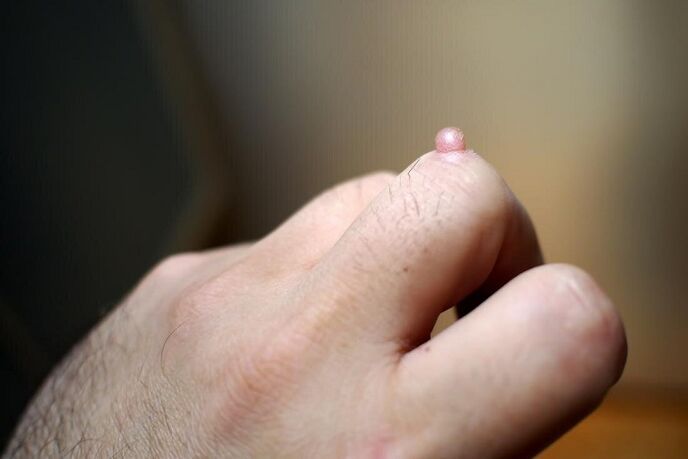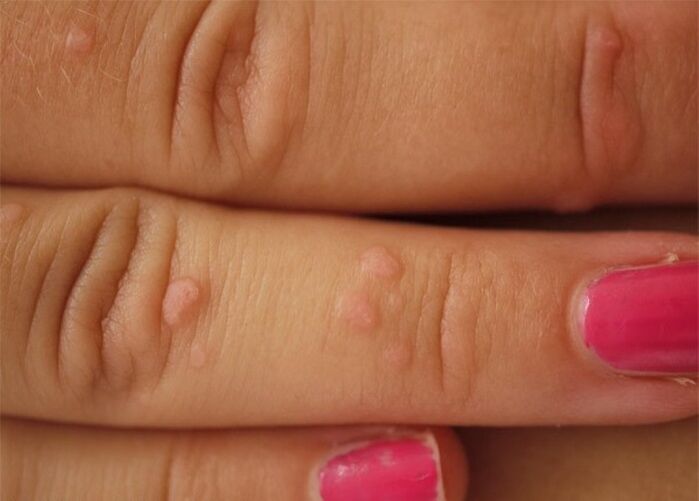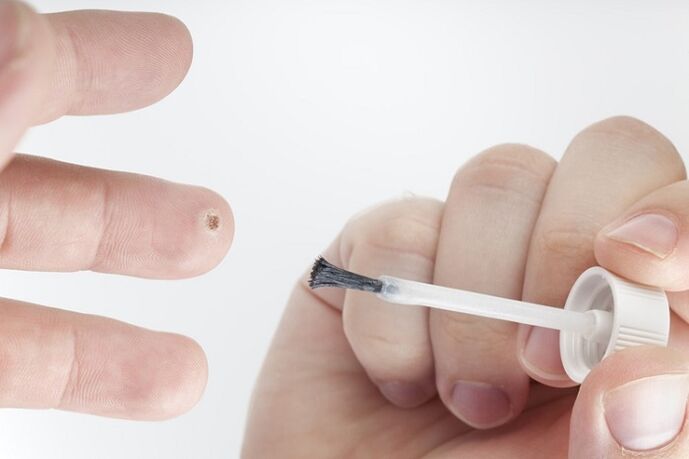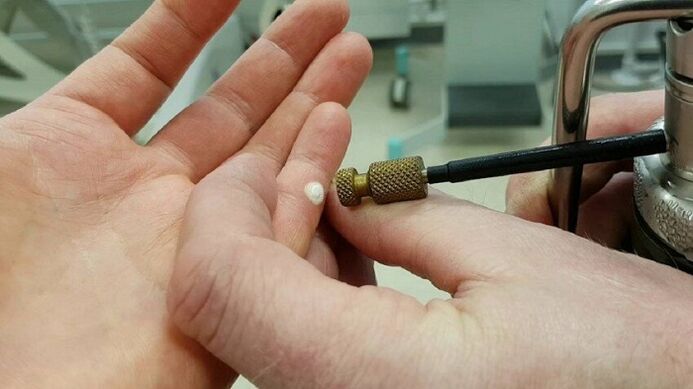Warts, as you already know, are caused by human papillomavirus. They can be located on almost any part of the body, often warts appear on the hands. When are warts dangerous and require medical attention? How to prevent the appearance of warts on your hands? You will find the answers to these questions in the following article.

Warts on the hands
A wart (verruca) is a benign contagious skin lesion that resembles a papule or papilloma.
Common and flat warts and genital warts are caused by a common virus - Tumefaciens verrucarum. The incubation period is long (2-5 months). Histologically, according to the clinical form, there are different severity of papillomatosis, acanthosis, hyperkeratosis; In styloid layer cells - perinuclear vacuoles.
The common wart (verruca vulgaris) is a dense, non-inflammatory nodule, from pin to pea, brownish or yellowish, with a rough surface. Most often localized on the hands. Ordinary warts can appear in large numbers.
The wart is flat or youthful (verruca plana, s. Juvenilis) - a flattened papule, slightly raised above the level of healthy skin, with rounded or polygonal contours, fleshy or yellowish-pink in color, with a matte, sometimes shiny surface. Flat warts are usually numerous, appearing on the face, on the back of the hands in young people, mostly of school age.
Plantar wart (verruca plantaris) - a species similar to the common wart callus - is localized in the areas of greatest pressure, mainly at the head of the metatarsal bone and around the heel. Painful for pressure. After removing the corneal masses from the surface of the wart, papillary formations are exposed.
Genital warts (condyloma acuminatum) appear as a small pink papule, then grow, taking on a papillary shape. When the papules merge, extensive vegetation is formed. Characterized by a soft consistency, a narrow base in the form of a foot. More often it develops on the genitals, groin and intermediate folds, with unclean skin care and maceration.
Properties of warts on hands and palms
Warts can affect absolutely any part of the epidermis of the hands, but most often they occur on the back of the hand or around the fingers. Moreover, most of these formations belong to the vulgar formations, which do not differ in color from healthy skin and are relatively small - 0. 1-1 cm.
As for the number of such neoplasms, there is one defect of the skin as well as many warts that are prone to fusion.
The distinguishing marks of palm warts are the following:
- Lack of pain and itching;
- The site of the skin defect does not have an epidermal pattern that usually recovers after wart removal;
- Black dots representing coagulation vessels may appear on the surface of the formation.
From all of the above, we can conclude that warts are a more aesthetic defect than palms, which, however, in the absence of timely treatment, can lead to significant proliferation of neoplasms and a high risk of their mechanical damage.

How to detect a wart
A wart looks like a mass that rises above the skin, in a different color from the skin. Most often, several warts appear at once. At the same time, the localization can be very diverse: from the wrists and face to the soles of the feet (plantar warts). Warts can appear on the wrist and even under the nail! The touch is rough to the touch, or conversely, smooth and flat.
Papillomas that appear in groups can merge.
Vulgar (common) warts usually appear on the fingers. The vulgar wart looks like a growth no more than a centimeter in size, its color is brown or gray and is dome-shaped. Black dots may appear inside the formation. Flat small warts often appear on the hands and they are characterized by the appearance of bands. Their color is pink or yellowish.
Reasons for appearance
Warts on the fingers and other parts of the body are exclusively viral in nature and are associated with the entry of human papillomavirus into a patient's blood. Based on this, treatment of warts on the fingers, palms and elbows should be aimed at eliminating the underlying cause. Unfortunately, to date, no medical technique can completely rid a patient's blood of the virus, which further explains the symptomatic therapy of neoplasms.
An important accompanying factor that causes warts to appear on the hands is a weakening of the body’s immune response, which can occur in the background of overwork, malnutrition or an infectious process. Given that HPV can enter the bloodstream as a result of damage to the epidermis, the role of microtraumas, scratches, and small wounds, which are not uncommon on the skin of the hands, is noteworthy. In view of all the above, you can re-evaluate the importance of personal hand hygiene.
Despite all of the above, HPV infection is not critical. Statistics show that about 90% of all people are carriers of the virus, which may not be detected for a long time, be in a latent state in the blood.
As already mentioned, these neoplasms occur due to the penetration of the HP virus into the body, which has more than a hundred types. This virus is quite common and common warts are found in twenty percent of school children.
It is important to remember that the attack multiplies quite intensively - through the emergence of the upper layers. Moreover, the person from whom you caught the "wart" virus may not have the warts themselves. HPV is particularly fond of skin microcracks and microtraumas, so most of them are "brought" by people from public pools and reservoirs.
If you do not take measures to cure and do not remove such a rash, complications can arise: they can spread throughout the body and even disappear, they will come back again. Keloid scars can form when warts are removed at home.
Symptoms of warts on hands and fingers
Of course, warts, for all their safety, should not be ignored as they can cause quite a lot of trouble. Moreover, they are contagious and can be transmitted to new and new victims with a simple touch.
By the way, the appearance of such a rash should be a reason to think about your own immunity, because people with impaired immunity are at risk. Many stresses weaken our immunity and consequently such people also become open to such a virus.
How to detect a wart? Around the papilla or nodule that rises above the skin, the skin will be typically light or, conversely, dark. The bump appears on more than one, usually on the forehead, cheeks, arms and legs, small warts appear, dense and fleshy, smooth and flat. Rough growths appear around or under the nails, and on the feet you may also notice neoplasms that are oval or round in shape and which are painful to step on. By touch, they are slightly rough or smooth and flat, they can unite in groups into a single neoplasm.
The wart virus can linger in your body for years, and its incubation period can last up to six months, so do not be surprised if they appear suddenly for any apparent reason.
Warts can be different: there are vulgar or common, flat, plantar, as well as scaly and genital varieties. Common warts are those that appear on the feet and hands, elbows and knees, and fingers and toes. These are small growths, no larger than a centimeter, hard to the touch, brown or gray in color. Their shape is usually domed.
The ordinary or vulgar surface can be rough, on the outside it looks like a cauliflower, while on the inside black dots stand out. The flat type includes those with dimensions up to five millimeters, distinguished by a smooth flat surface, as well as pink, yellowish or light brown in color. Typically, these formations appear on the face, but can grow in clusters on the hands or knees.
The most annoying are plantar warts: they cause a lot of trouble while walking, causing the sensation as if a pebble has hit a shoe. They are usually quite harsh, dirty gray in color. The shape of the slab grows on the face - around the nose, neck, mouth. They are elongated and resemble the shape and color of a finger.
Warts also include genital warts, also called genitals: they develop on the genitals as well as on the buttocks and buttocks and are a direct result of an unclean attitude towards your body. Outwardly, they look like pink knots, often fused, have a base that resembles a foot.

When to see a doctor
- If the wart quickly changes shape, color or all together;
- If the wart has an uneven color;
- If the borders of the wart are blurred (in this case, most likely, it is not a wart);
- If the wart hurts or is permanently injured (this increases the risk of it becoming more serious);
- If the number of warts gradually increases;
- If the wart has bleeding or itching;
How to get rid of papilloma on your hands
Warts cause a lot of discomfort in our daily lives. In conspicuous places they do not look aesthetically pleasing; With awkward localization, they quickly become injured and cause pain. Therefore, very often people go to a dermatologist when warts appear. Because of their malignancy, oncologists are also involved in warts.
Since the appearance of warts is related to provoking factors, treatment often complements the intake of vitamin-mineral complexes, sedatives and immunity-boosting agents. Otherwise, mechanical removal of papillomas may not give the desired result and after a certain period of time they will start growing again.
The desire to get rid of warts sometimes leads to bad results. Folk remedies offered by various advisors can not only not remove warts, but also contribute to its malignancy. You have to be very careful here. Treatment of warts at home should not involve the use of traditional medicine, but the use of special preparations purchased at the pharmacy.
It is even easier to trust the professionals of private clinics. Or make an appointment with your dermatologist, oncology dispensary.
Papilloma removal methods
Today, private and public clinics can offer a fairly wide range of methods to eliminate warts. Listen to your doctor's recommendations before choosing a removal technique. Your doctor will advise you on the most appropriate intervention based on your individual characteristics. In particular, they are:
- Cryodestruction. . . Considers the use of liquid nitrogen to destroy papillomas. Nitrogen is applied to the wart, usually with an applicator, and the formation is frozen for fifteen to twenty seconds. To date, applicators have been developed that are easy to use at home. They can be purchased at a reasonable price in pharmacies.
- Electrocoagulation.Cut the papilloma with a thin metal loop under high frequency current. Local anesthesia is performed before the operation. Complete cure occurs in a week.
- Laser coagulation. . . It is similar to electrocoagulation, using only a laser instead of power.
- surgery. . . Under local anesthesia, the wart is excised with a scalpel, the surgical wound is sutured with a cosmetic suture. It is used only for the removal of large papillomas.
- Chemical methods. . . They are very rarely used because the risk of damaging the surrounding tissues is very high.

What to do to disperse warts on your hands
The son of one woman was only four years old when warts appeared on his arms. There were so many that the mother in kindergarten was asked not to even take her there. And what they just did not do with this trouble! Doctors advised to burn warts with acid. But the woman still decided to resort to folk remedies for the treatment of warts.
Cut the thuja branch (palm size) into 3-7 mm long pieces. Place in a glass vial, for example, with hydrogen peroxide, pour alcohol. Close with a stopper and leave for 12 days, stirring occasionally. After 12 days, open and keep the bottle open for 1-2 days. After that, the tincture is ready for use.
You need to pour a cotton ball on the matchstick in it and lubricate the warts several times a day. Lubrication six times a day is recommended. And after such treatment, the warts finally started to disappear from the boy's skin without a trace. However, do not expect immediate results. So since the course of treatment for the boy was quite long. By the way, the tincture can be stored for a very long time.
Propolis for warts on the fingers
For a very long time - more than six years - one woman could not get rid of a wart on her finger. He tried to burn it with liquid nitrogen, but the wart continued to grow. He even went to the oncologist because he had already started thinking that it was a malignant tumor.
But in the hospital his fear was not confirmed and the doctor suggested that he take a piece of propolis the size of a wart, put it in his mouth and soften it with saliva. At this time, in slightly warm water - clean, without any additives - hold the finger with a fork for 30-40 minutes so that it also softens. Then you need to clean your finger and apply propolis on the wart that has just softened in your mouth.
It should be protected with adhesive tape for three or four days. It was written in the lunar calendar that it is best to start removing warts during a full moon and continue until the new moon.
On the eve of the new moon, remove all the bandages and stop the treatment until the full moon and start again on the full moon.
With such a folk method of treating warts he painlessly got rid of this unpleasant trouble. If you have small warts, you may be able to get rid of warts on one full moon to treat a new moon.
Wart prevention
It is known that the disease is easier to prevent than to cure later. This fully applies to warts. First of all, you need to follow the basic rules of personal hygiene.
Do not walk barefoot in common areas, especially in wet areas - such as showers, dressing rooms, swimming pools; Do not abuse shoes in which the feet are constantly sweating, or at least find the opportunity to dry qualitatively; Do not touch unnecessary warts or objects or objects that the patient has touched with you.
You also need to pay attention to your general health and especially your immune system - follow a balanced diet and lead a healthy lifestyle.
It will also be good to learn to relax and avoid stress - this will guarantee that you will get rid of not only the possible appearance of warts, but also a whole range of possible diseases.














































































